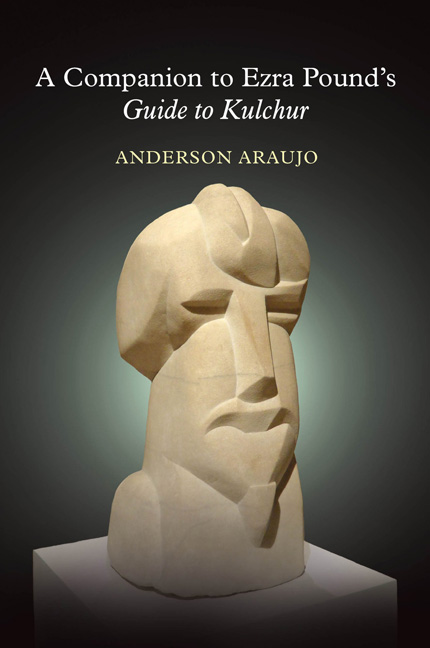Book contents
- Frontmatter
- Contents
- Acknowledgments
- Abbreviations
- Introduction
- Guide to Kulchur
- Part I
- Section I
- 1 Digest Of The Analects
- 2 The New Learning: Part One
- 3 Sparta 776 B.C.
- 4 Totalitarian
- 5 Zweck or the Aim
- Section II
- Part II
- Section III
- Section IV
- Part III
- Section V
- Section VI
- Part IV
- Section VII
- Section VIII
- Section IV
- Part V
- Section X
- Section XI
- Part VI
- Section XII
- Section XIII
- Addenda: 1952
- Notes
- Index
1 - Digest Of The Analects
from Section I
- Frontmatter
- Contents
- Acknowledgments
- Abbreviations
- Introduction
- Guide to Kulchur
- Part I
- Section I
- 1 Digest Of The Analects
- 2 The New Learning: Part One
- 3 Sparta 776 B.C.
- 4 Totalitarian
- 5 Zweck or the Aim
- Section II
- Part II
- Section III
- Section IV
- Part III
- Section V
- Section VI
- Part IV
- Section VII
- Section VIII
- Section IV
- Part V
- Section X
- Section XI
- Part VI
- Section XII
- Section XIII
- Addenda: 1952
- Notes
- Index
Summary
DIGEST OF THE ANALECTS: The Analects (Lun Yu, 論語/ 论语), a compilation of the philosophical reflections of Confucius (Kŏng Qīu, 孔丘, 551–479 BCE). In June 1937, just a few months after he began to write GK, Pound published his abridged translation of the Analects with Giovanni Scheiwiller, a Milan publisher, bearing the same title as the heading of the present chapter. With the exception of two brief passages, the text is reprinted in its entirety in this chapter. In 1951, Pound would reprint his translation of the complete text under the shorter title, Confucian Analects, first published in the Hudson Review the previous year. Pound first read Confucius as early as July 1907, but it was only when he wintered in 1914–15 at Yeats's Stone Cottage at Coleman's Hatch, near Ashdown Forest in Sussex, that he began to read the Chinese philosopher in earnest. He came to the serious study of Confucius through sixteen notebooks containing draft translations of Chinese poetry, Noh dramas, and other material bequeathed to him between 1913 and 1915 by the widow of Ernest Fenollosa (1853–1908), an American art historian and professor of political economy and philosophy at Tokyo University. Among Fenollosa's literary papers was his essay, “The Chinese Written Character as a Medium for Poetry.” First published in Pound's Instigations (1920), the essay was published in book form by Stanley Nott in 1936, with a foreword and notes by Pound, as the first of two volumes Pound edited for Nott's “Ideogrammic Series.” Especially influential for Pound was Fenollosa's central argument that the Chinese ideogram “has not only absorbed the poetic substance of nature and built with it a second work of metaphor, but has through its very pictorial visibility, been able to retain its original creative poetry with far more vigor and vividness than any phonetic tongue.” This notion is the impetus behind his “ideogrammic method,” described in Guide as consisting “of presenting one facet and then another until at some point one gets off the dead and desensitized surface of the reader's mind, onto a part that will register” (GK 51).
- Type
- Chapter
- Information
- A Companion to Ezra Pound's Guide to KulcherGuide to Kulcher, pp. 30 - 40Publisher: Liverpool University PressPrint publication year: 2018



